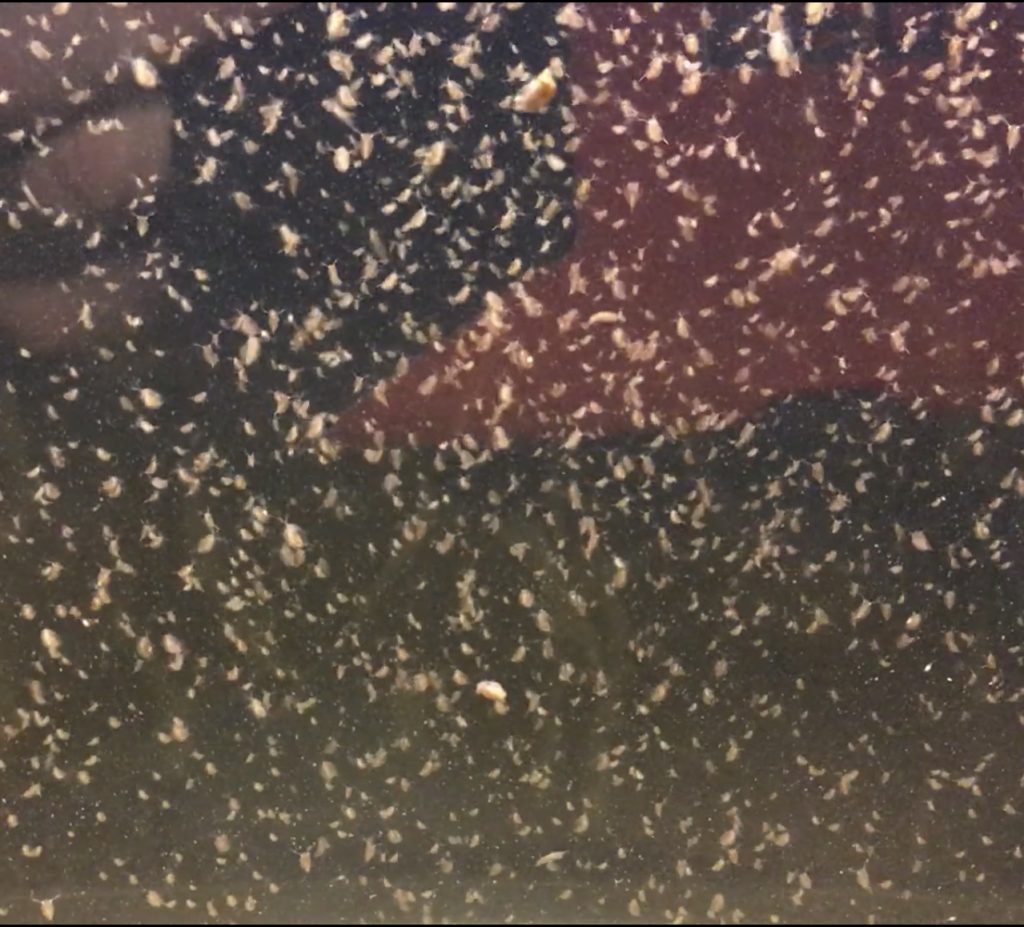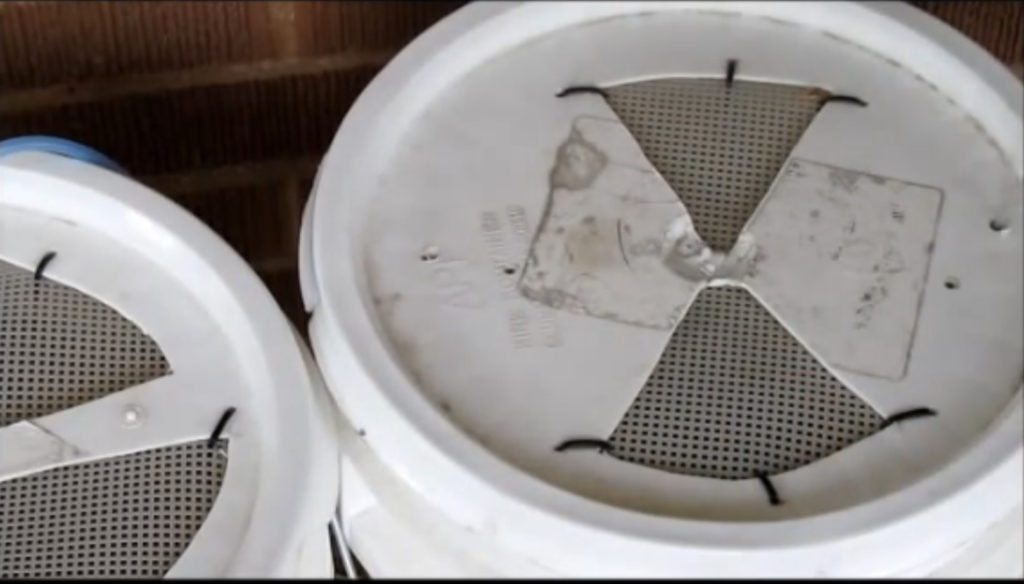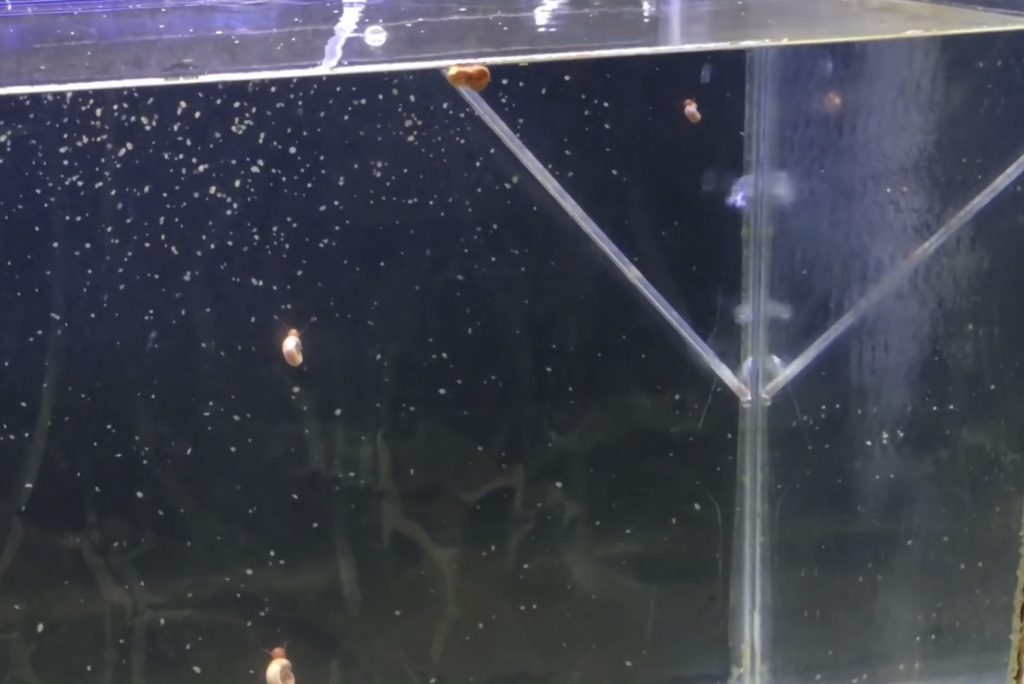Daphnia are a great live food for aquarium fish and aquatic amphibians. Culturing daphnia can actually be fun, too. Learn how to culture daphnia:

Supplies for Culturing Daphnia:
A culture container. For the moment, let’s assume you want to culture moderate to large numbers of daphnia. I recommend a container of 5 to 20+ gallons. For more daphnia production, go bigger, and/or use multiple containers.
A five-gallon bucket is a good inexpensive option. You can also use an aquarium, or just about any kind of plastic or glass tub or bin that is large and sturdy enough..
Some kind of cover may be necessary if you need to keep curious animals or small children out. On my 20-gallon daphnia culture, aimuse an aquarium lid. Below, I have used craft mesh and zip ties to allow some light and air in, while providing some protection:

I highly recommend light aeration to maximize production in a daphnia culture. I recommend against using the fine bubbles created by an airstone, as these fine bubbles can get lodged within the body cavity of the daphnia, trapping them at the surface of the water, where they die.

To provide aeration, you’ll need an inexpensive air pump:
You will also require some airline tubing. I prefer to use some flexible airline tubing with about 1 foot of rigid airline tubing on the end in the aquarium. I also use a check valve to prevent backsiphoning water into the pump, and a gang valve to regulate the airflow precisely:
Now that you have the container and aeration equipment, it’s time to think about the water. Daphnia tend to be sensitive to heavy metals, as well as chlorine and chloramine. Depending on your water supply and your particular strain of daphnia, you may need to rely on aged water from established aquariums to do your water changes. With my water and daphnia, I am able to use water from the tap, once i dechlorinate it. I use Seachem Prime:
Daphnia kept at reasonable room temperatures do not need a heater. Lighting is optional. I like to use a light, for a couple of reasons. For one, lots of daphnia will congregate at the surface near the light, making it easier to harvest them. The light will also encourage some beneficial algae growth
You will want a net or two for harvesting the daphnia. I recommend at least two nets. A brine shrimp net is great for harvesting mixed sizes of daphnia:
A net with a coarser weave is useful for collecting larger daphnia while leaving many of the smaller ones behind to grow and reproduce:
You will also need daphnia food. Contact me if you would like to buy a couple of ounces, which will last a 20-gallon culture for a few months. . You can also make your own daphnia food mix, if you don’t mind buying large quantities of infpgredients. Here are the ingredients to make your own:
One part pure Spirulina powder:
One part green pea powder:
One part brown rice flour:
Do not feed this mixture to the daphnia in its dry state.mix about 1 teaspoon of this powder mixture into 2 oz. of purified water. I keep this watery mixture in the refrigerator. One to 2 ml 3-5 days per week seems enough for my 20-gallon daphnia culture. My daphnia culture also gets some algae and other foods (since they eat the fine particles the scuds scatter into the water column) so you may need to,tweak your feeding regimen depending on your particular setup.
Now that you have all of the supplies, add the appropriately aged (or dechlorinated) water to your container, set the air pump to make a small trickle of air in one corner or along one side of the enclosure, and let it run for a few days before you get your daphnia.
You can purchase daphnia from various sources. I usually have daphnia available. Here is a seller on Amazon:
When they arrive, it is often best to acclimate your daphnia slowly to the new water conditions, especially if they have arrived in a breather bag. You can use drip acclimation, which is hasically just a slow siphon, using a piece of airline tubing with a loose knot in it. This allows your aquarium water to drip slowly into the shipping bag, which is sitting in a jar or similar container for the drip process. Allow the tank water to drip slowly, about 1 drop per second, into the daphnia shipping bag until it is 50% fuller (If there is enough space in the bag.) at this point, the daphnia should be a little more acclimated to your water, and you can empty the shipping bag into your culture container.
Feed the daphnia lightly for the first few days. Generally, within a week to 10 days, the daphnia will have produced lots of tiny daphnia, and within a few weeks, you will have a booming culture.
There are a few things you can do to keep that culture thriving.
First, perform weekly partial water changes of 25-50%. A lot of people worry about sucking up too many daphnia during water changes. Just try to keep the intake of the siphon away from the bulk of the daphnia. You’ll probably siphon out some. If you strain the water through a large brine shrimp net, you have a nice snack for your fish.
Harvest regularly. The daphnia population will reach a certain point and then level off, but if you harvest from the culture weekly or twice weekly (about 50% of the daphnia), you can help avoid the culture reaching that leveling-off stage.
Adapt your feeding schedule according to your daphnia population. Daphnia need plenty of food, but too much is not a good thing. It will take some tweaking to figure out exactly how much to feed, and that will vary as your daphnia population changes.
Watch for drastic reductions in population. If you notice a sudden drop in daphnia numbers, ask yourself a few questions. Have you been keeping up with water changes? Have you harvested too many or too few daphnia? Have you changed something about the food? Is the aeration too strong, or too weak? Usually, one of these factors can be tweaked, putting your culture back on track again.
Do you need more information on Daphnia? Check out some of my videos on the topic:
I am a participant in the Amazon Services LLC Associates Program, an affiliate advertising program designed to provide a means for sites to earn advertising fees by advertising and linking to amazon.com. In other words, I earn a small commission when you use that affiliate link, at no cost to you.
